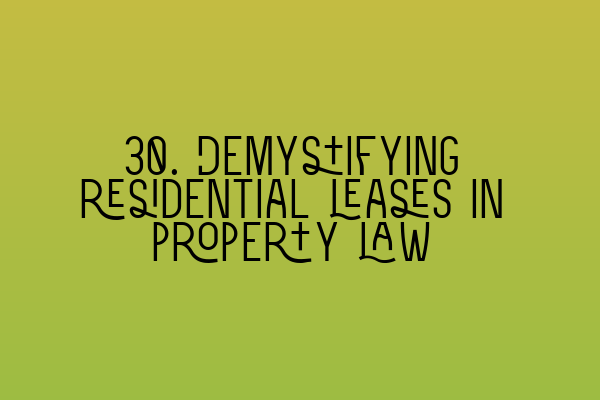Demystifying Residential Leases in Property Law
When it comes to property law, one area that can often be confusing and complex is residential leases. Understanding the ins and outs of residential leases is essential, whether you are a property owner, tenant, or a legal professional in the field of property law. In this article, we will demystify residential leases and break down the key concepts that you need to know.
What is a Residential Lease?
A residential lease, also known as a rental agreement or tenancy agreement, is a legal contract between a landlord and a tenant. It outlines the terms and conditions for renting a residential property, including the rights and obligations of both parties.
Residential leases commonly cover rental properties such as apartments, houses, condominiums, and townhouses. These leases can be for various durations, ranging from monthly agreements to long-term leases lasting several years.
Key Components of a Residential Lease
To better understand residential leases, let’s explore the key components that are typically included:
1. Parties Involved
A residential lease begins by clearly identifying the parties involved. This includes the full legal names of the landlord and tenant, as well as their contact information.
2. Property Description
The lease should include a detailed description of the property being rented. This may include the address, unit number, and any specific areas or amenities included with the rental.
3. Rental Term
The rental term specifies the duration of the lease agreement, whether it’s a fixed term or a periodic tenancy. It is crucial to clearly state the start and end dates of the lease to avoid any confusion or disputes.
4. Rent Amount and Payment Terms
The lease should outline the agreed-upon rent amount and how it should be paid (e.g., monthly, quarterly, or annually). It is also important to specify the accepted payment methods and any penalties for late payments.
5. Security Deposit
A security deposit is a sum of money paid by the tenant as security against potential damages or unpaid rent. The lease should clearly state the amount of the security deposit, along with any conditions for its return at the end of the tenancy.
6. Maintenance and Repairs
The responsibilities for maintenance and repairs should be clearly defined in the lease agreement. This includes specifying who is responsible for routine maintenance, repairs, and any costs associated with them.
7. Tenant’s Rights and Obligations
The lease should outline the rights and obligations of the tenant, including restrictions on alterations to the property, noise levels, and pet policies. It may also cover the tenant’s responsibilities for keeping the property clean, reporting damages, and complying with any applicable laws or building regulations.
8. Landlord’s Rights and Obligations
The lease should also clearly define the rights and obligations of the landlord. This may include providing the tenant with quiet enjoyment of the property, maintaining the property in a habitable condition, and respecting the tenant’s privacy rights.
9. Termination and Renewal
The lease should include provisions for termination and renewal of the tenancy. This may include notice periods required for both parties, conditions for terminating the lease early, and options for renewal at the end of the lease term.
10. Governing Law
The lease should specify the governing law that applies to the agreement. This is important for determining which jurisdiction’s laws will govern any disputes or legal issues that may arise during the tenancy.
Importance of Professional Legal Assistance
Residential leases can be complex legal documents, and it is highly recommended to seek professional legal assistance when dealing with them. Property law solicitors specializing in lease agreements can provide you with expert guidance and ensure that your rights and interests are protected.
Whether you are a landlord drafting a lease or a tenant reviewing a lease before signing, having a solicitor’s input can help clarify any confusing clauses, negotiate favorable terms, and provide peace of mind.
Furthermore, studying property law and becoming proficient in understanding residential leases is essential for legal professionals in this field. The SQE 1 Practice Exam Questions and SQE 1 Practice Mocks FLK1 FLK2 can be valuable resources and practice tools to enhance your knowledge of property law.
Stay up to date with the latest developments and changes in property law by regularly attending SRA SQE Exam Dates and enrolling in SQE 1 Preparation Courses and SQE 2 Preparation Courses.
In Conclusion
Understanding and demystifying residential leases is crucial in property law. By familiarizing yourself with the key components of a lease, seeking professional legal assistance when needed, and staying abreast of relevant legal developments, you can navigate residential leases with confidence whether you are a landlord, tenant, or legal professional.
